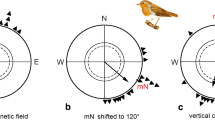Summary
-
1.
Volvox usually is photopositive in low and photonegative in high illumination, but the opposite obtains under certain conditions.
-
2.
If it is dark adapted, it is always positive when exposed to light, no matter how intense, but it soon becomes negative if the light is sufficiently intense and the higher the intensity the shorter the time required.
-
3.
If Volvox is fully adapted to any given illumination it becomes positive if the intensity is increased and negative if it is decreased, provided the change in intensity is sufficiently great and sufficiently rapid.
-
4.
Colonies which have thus become positive remain so for a time, then they become neutral and later negative if the change of intensity is sufficiently great. The greater the change in intensity the sooner they become negative. The reverse obtains in colonies which have become negative.
-
5.
If colonies are negative in a given luminous intensity and the intensity is momentarily reduced they become positive, remain so for a time, then become negative again. The time they remain positive varies directly with the magnitude of the reduction of the light and the time it remains reduced. The opposite obtains for colonies which are positive in a given luminous intensity.
-
6.
Volvox may be either photopositive or photonegative in every condition of luminous intensity in which orientation occurs.
-
7.
Darkness or reduction in luminous intensity induces changes which result in reversal from photonegative orientation in a given illumination to photopositive orientation in the same illumination, and light or increase in luminous intensity induces changes which result in the opposite.
-
8.
If colonies are subjected to any given constant illumination, they become neutral, i. e. they become adapted to that illumination and orientation ceases.
-
9.
Colonies which in any given illumination are not fully adapted, usually become negative if the intensity is increased and positive if it is decreased, precisely the opposite from that which obtains in colonies which are fully adapted.
-
10.
Photopositive orientation is brought about primarily by a change in the direction of the stroke of the flagella on the shaded side of the colonies from diagonally backward to more nearly directly backward and photonegative orientation by the same change on the illuminated side. The one is due to decrease, the other to increase in the illumination of the sensitive tissue in the eyes.
-
11.
Decrease in the illumination of the photoreceptors in colonies in the photopositive state has the same effect as increase in the illumination of the same structure in colonies in the photonegative state.
-
12.
This difference is probably associated with the difference in the electric charge on colonies in the two states, indicated in the results presented in a subsquent paper.
-
13.
It is assumed that response to light in Volvox is associated with photochemical changes, and an attempt has been made to account for reversal in the direction of photic orientation on the basis of postulated photochemical processes.
Similar content being viewed by others
Literature Cited
Mast, S. O.: 1907. Light reactions in lower organisms. II. Volvox. Journ. of comp. neurol. a. psychol. 17, 99–180.
Ders.: 1911. Light and the Behavior of Organisms. New York. 410 S.
Ders.: 1918. Effects of chemicals on reversion in orientation to light in the colonial form, Spondylomorum quaternarium. Journ. of exp. zool. 26, 503–520.
Ders.: 1919. Reversion in the sense of orientation to light in the colonial forms, Volvox globator and Pandorina morum. Ibid Journ. of exp. zool. 27, 367–390.
Ders.: 1926. Reactions to light in Volvox, with special reference to the process of orientation. Zeitschr. f. vergl. Physiol. 4, 637–658.
Oltmanns, J.: 1917. Über Photaxis. Zeitschr. f. Bot. 9, 257–338.
Author information
Authors and Affiliations
Rights and permissions
About this article
Cite this article
Mast, S.O. Reversal in photic orientation in Volvox and the nature of photic stimulation. Z. Vergl. Physiol. 5, 730–738 (1927). https://doi.org/10.1007/BF00302275
Received:
Issue Date:
DOI: https://doi.org/10.1007/BF00302275




